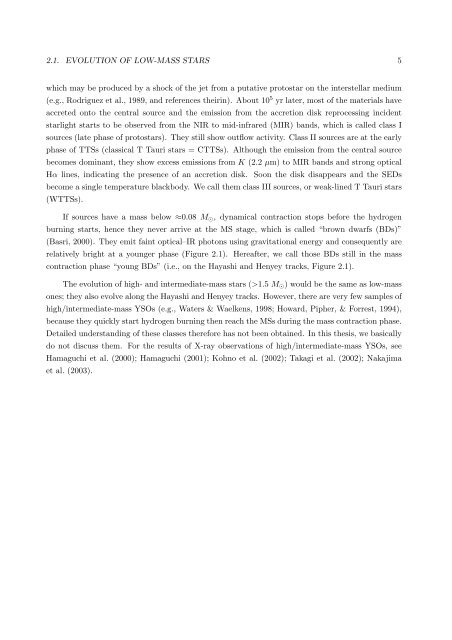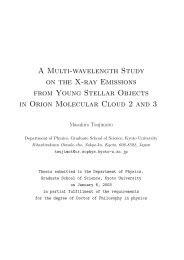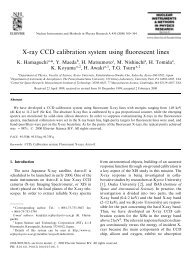X-ray Study of Low-mass Young Stellar Objects in the ρ Ophiuchi ...
X-ray Study of Low-mass Young Stellar Objects in the ρ Ophiuchi ...
X-ray Study of Low-mass Young Stellar Objects in the ρ Ophiuchi ...
Create successful ePaper yourself
Turn your PDF publications into a flip-book with our unique Google optimized e-Paper software.
2.1. EVOLUTION OF LOW-MASS STARS 5which may be produced by a shock <strong>of</strong> <strong>the</strong> jet from a putative protostar on <strong>the</strong> <strong>in</strong>terstellar medium(e.g., Rodriguez et al., 1989, and references <strong>the</strong>ir<strong>in</strong>). About 10 5 yr later, most <strong>of</strong> <strong>the</strong> materials haveaccreted onto <strong>the</strong> central source and <strong>the</strong> emission from <strong>the</strong> accretion disk reprocess<strong>in</strong>g <strong>in</strong>cidentstarlight starts to be observed from <strong>the</strong> NIR to mid-<strong>in</strong>frared (MIR) bands, which is called class Isources (late phase <strong>of</strong> protostars). They still show outflow activity. Class II sources are at <strong>the</strong> earlyphase <strong>of</strong> TTSs (classical T Tauri stars = CTTSs). Although <strong>the</strong> emission from <strong>the</strong> central sourcebecomes dom<strong>in</strong>ant, <strong>the</strong>y show excess emissions from K (2.2 µm) to MIR bands and strong opticalHα l<strong>in</strong>es, <strong>in</strong>dicat<strong>in</strong>g <strong>the</strong> presence <strong>of</strong> an accretion disk. Soon <strong>the</strong> disk disappears and <strong>the</strong> SEDsbecome a s<strong>in</strong>gle temperature blackbody. We call <strong>the</strong>m class III sources, or weak-l<strong>in</strong>ed T Tauri stars(WTTSs).If sources have a <strong>mass</strong> below ≈0.08 M ⊙ , dynamical contraction stops before <strong>the</strong> hydrogenburn<strong>in</strong>g starts, hence <strong>the</strong>y never arrive at <strong>the</strong> MS stage, which is called “brown dwarfs (BDs)”(Basri, 2000). They emit fa<strong>in</strong>t optical–IR photons us<strong>in</strong>g gravitational energy and consequently arerelatively bright at a younger phase (Figure 2.1). Hereafter, we call those BDs still <strong>in</strong> <strong>the</strong> <strong>mass</strong>contraction phase “young BDs” (i.e., on <strong>the</strong> Hayashi and Henyey tracks, Figure 2.1).The evolution <strong>of</strong> high- and <strong>in</strong>termediate-<strong>mass</strong> stars (>1.5 M ⊙ ) would be <strong>the</strong> same as low-<strong>mass</strong>ones; <strong>the</strong>y also evolve along <strong>the</strong> Hayashi and Henyey tracks. However, <strong>the</strong>re are very few samples <strong>of</strong>high/<strong>in</strong>termediate-<strong>mass</strong> YSOs (e.g., Waters & Waelkens, 1998; Howard, Pipher, & Forrest, 1994),because <strong>the</strong>y quickly start hydrogen burn<strong>in</strong>g <strong>the</strong>n reach <strong>the</strong> MSs dur<strong>in</strong>g <strong>the</strong> <strong>mass</strong> contraction phase.Detailed understand<strong>in</strong>g <strong>of</strong> <strong>the</strong>se classes <strong>the</strong>refore has not been obta<strong>in</strong>ed. In this <strong>the</strong>sis, we basicallydo not discuss <strong>the</strong>m. For <strong>the</strong> results <strong>of</strong> X-<strong>ray</strong> observations <strong>of</strong> high/<strong>in</strong>termediate-<strong>mass</strong> YSOs, seeHamaguchi et al. (2000); Hamaguchi (2001); Kohno et al. (2002); Takagi et al. (2002); Nakajimaet al. (2003).

















